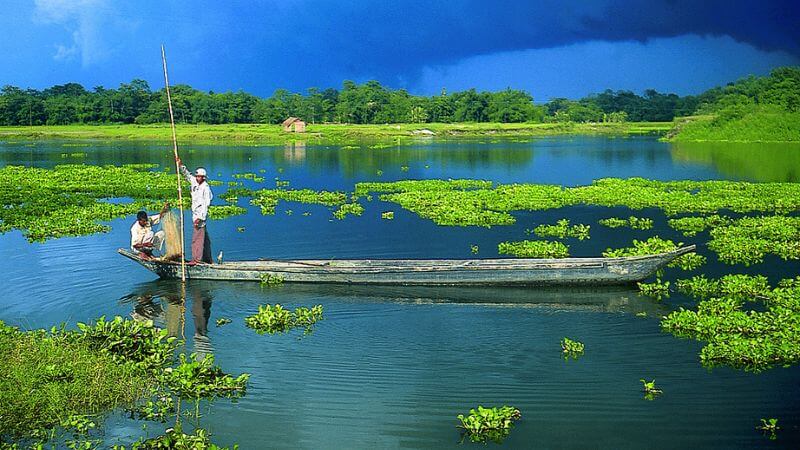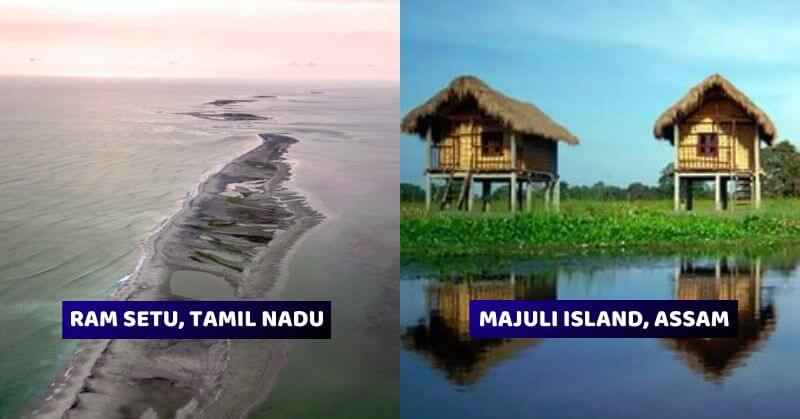There are a lot of places that exist in the country to visit at least once in life. Some of the places are there in endangered to get disappear in the future. We are going to see such unique places that are in danger of disappearance due to many factors caused by both humans and nature. Here is the list of unique places in India that you must visit before they disappear.
1. Majuli Island, Assam


Majuli is an attractive and lush green river island formed by the river Brahmaputra in the south and the Kherkutia Xuti joined by the Subansiri River in the north. This pollution-free island is located in Assam. It is about 300 to 400 kilometers east of the city of Guwahati and at an accessible distance from the city of Jorhat. Majuli wetland has been providing shelter for a wide variety of flora and fauna. Siberian crane, pelican, greater adjutant stork, and whistling teal are some of the birds dwelling there.
From a total of 1150 kilometers squares, the area of Majuli was eroded to 553 square kilometers as of 2014. And it was estimated in the surveys that Majuli will not be there in 15 to 20 years. The government also trying to protect this island from soil erosions and a nomination has been sent to UNESCO to name it a World Heritage Site.
2. Rakhigarhi, Haryana
Rakhigarhi is the largest Indus Valley Civilization located in the Ghaggar-Hakra River plain. Now it is formed as a small village in Haryana. It is situated 150 km to the northwest of Delhi and 27 km from the seasonal Ghaggar River. It has 11 excavation mounds named RGR1 to RGR11. Rakhigarhi covers a total area of 550 hectares in which the mounds RGR1 to RGR6 are residential sites. The Rakhigarhi Indus Valley Civilization Museum in Rakhigarhi is under construction. There is also a museum called Haryana Rural Antique Museum 60 km away from Rakhigarhi. The site is not in proper protection, the studies found, causes the site to face several threats of loss and destruction like soil erosion, illegal sand lifting, artifacts theft, illegal sale, and villagers encroachments.
3. Wular Lake, Jammu And Kashmir
Wular Lake is one of the 46 Indian wetlands designated as a Ramsar site. It is also one of the largest freshwater lakes in Asia. It is located in the Bandipora district in Jammu and Kashmir. Wular Lake extends seasonally from 30 to 189 square kilometers. Fishing is the living hood of most of the people in that site and also habitant of many terrestrial birds. Environmental threats like conversion of catchment areas into agricultural land, pollution from animal wastes, hunting of migratory birds, and weed infestation may shrink the water body and cause it to disappear in the future.
4. Sunderbans, West Bengal
Sunderbans is considered the world’s largest mangrove ecosystem. It is formed by the merging of the Ganges, Brahmaputra, and Meghna rivers in the Bay of Bengal. It consists of four UNESCO World Heritage sites including Sundarbans National Park, Sundarbans West, Sundarbans South, and Sundarbans East Wildlife Sanctuaries. Both human and natural causes like cyclones, sea-level rise, and depleting biodiversity may submerge the whole area underwater in the future.
5. Ram Setu, Tamil Nadu
Ram Setu is also known as Adam’s Bridge. It is a chain of limestone shoals that extend from India’s Pamban Island to Sri Lanka’s Mannar Island. Its length is about 48 km separating the Gulf of Mannar and Palk Strait. The project called Sethusamudram Shipping Canal Project to create a ship channel across the Palk Strait may dredge Adam’s Bridge structure and beauty.
6. Jaisalmer Fort, Rajasthan
Jaisalmer Fort is the second oldest fort in Rajasthan built in 1156 AD. It is situated in the city of Jaisalmer. Jaisalmer Fort is facing a lot of problems as the population is residing in the fort. It increases a lot of civic amenities, poor houses, and constructions, and earthquakes are other major problems. Jaisalmer Fort is also vulnerable to water seepage.
7. Balpakram Forest, Meghalaya
The forest-covered canon-cum-gorge makes the Balpakram forest an attractive and famous, worthy national park. The feature which makes it interesting and develops curiosity is the presence of a red panda. It is also an important dwelling place for the Asian elephant. It has been listed in the UNESCO World Heritage tentative list. There was a myth that the depression on the Schima Wallichii trunk is caused by the spirits that taking a rest on it. Construction of water dams and coal mining threaten the life of animals and diminish the forest area.
8. Coral Reef, Lakshadweep
Lakshadweep is one of the four coral reef regions in India. The corals create an attractive site for tourists. Most reefs found in the Lakshadweep are atolls except for one platform which has Androth. The typical atolls found in the Lakshadweep islands are Kalpeni, Kadmat, Kiltan, and Chetlat. The threats that cause danger to its existence include blast fishing, coral mining, and navigation path changing. Besides these, global warming is also added a threatening factor for coral reefs.
These are the unique places in India that you must visit before they disappear. Have you visited these unique places? How was your experience? Let us know in the comments below.
Follow Us: Facebook | Instagram | Twitter |
Entertales is on YouTube; click here to subscribe for the latest videos and updates.

